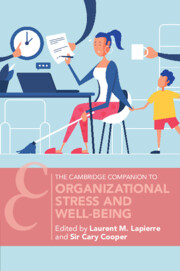Book contents
- Organizational Stress and Well-Being
- Cambridge Companions To Management
- Organizational Stress and Well-Being
- Copyright page
- Contents
- Figures
- Tables
- Contributors
- Introduction
- Part I Historical Evolution and Continued Relevance of the Study of Organizational Stress and Well-Being
- Part II Line Managers
- Part III Major Issues Relating to Stress and Well-Being
- 6 Work–Nonwork Balance and Employee Well-Being
- 7 Understanding the Decision-Making Process for Presenteeism Behavior
- 8 Burnout
- 9 Work Engagement and Organizational Well-Being
- 10 How and Why Gender Relates to Workplace Stress and Well-Being
- 11 The Measurement of Well-Being at Work
- Part IV Workplace Interventions Addressing Stress and Well-Being
- Part V Emerging Issues
- Subject Index
- References
6 - Work–Nonwork Balance and Employee Well-Being
from Part III - Major Issues Relating to Stress and Well-Being
Published online by Cambridge University Press: 23 February 2023
- Organizational Stress and Well-Being
- Cambridge Companions To Management
- Organizational Stress and Well-Being
- Copyright page
- Contents
- Figures
- Tables
- Contributors
- Introduction
- Part I Historical Evolution and Continued Relevance of the Study of Organizational Stress and Well-Being
- Part II Line Managers
- Part III Major Issues Relating to Stress and Well-Being
- 6 Work–Nonwork Balance and Employee Well-Being
- 7 Understanding the Decision-Making Process for Presenteeism Behavior
- 8 Burnout
- 9 Work Engagement and Organizational Well-Being
- 10 How and Why Gender Relates to Workplace Stress and Well-Being
- 11 The Measurement of Well-Being at Work
- Part IV Workplace Interventions Addressing Stress and Well-Being
- Part V Emerging Issues
- Subject Index
- References
Summary
This chapter reviews research on work–nonwork balance, starting with early research on the topic and discussing how the conceptualization and measurement of balance has changed over time. Drawing from social psychological research on attitudes and person-environment fit theory, balance is defined as a multi-dimensional construct with three facets: affective balance, effectiveness balance, and involvement balance. The measurement of both global balance and the facets of balance is discussed. The literature that examines the link between balance and employee well-being is reviewed. Finally, directions for future research on work–nonwork balance are discussed.
Keywords
- Type
- Chapter
- Information
- Organizational Stress and Well-Being , pp. 155 - 184Publisher: Cambridge University PressPrint publication year: 2023

